Are you tired of your steaks lacking flavor compared to those from your favorite restaurant? You may be using the right seasoning, but have you considered how long you let it sit on the steak before cooking? Many people make the mistake of not allowing enough time for the seasoning to marinate on their steak.
So, how long should steak sit after seasoning? The answer is simple – at least 30 minutes. While it may be tempting to throw your seasoned steak straight onto the grill, patience is key when it comes to enhancing its flavor. Allowing the seasoning to mix with the natural juices of the meat will result in a deeper and more delicious taste.
But if you have even more time on your hands, why not let your steak marinate overnight in the fridge? Cover it with cling wrap to prevent any air from drying out the meat, and you’ll be rewarded with an even more tender and flavorful steak.
The secret to a mouth-watering steak lies in giving your seasoning enough time to work its magic. So next time you’re grilling up some steaks at home, remember that patience is your friend. With just a little extra waiting time, you can enjoy restaurant-quality flavor from the comfort of your own kitchen.
Contents
Different Types of Seasonings for Steaks
First, let’s talk about the foundation of all great steak seasonings: salt. Salt helps to enhance the natural flavors of the meat and tenderize it. But why stop at just salt? You can take your seasoning game to the next level by adding a variety of herbs and spices.
One classic seasoning blend that never fails is a mixture of garlic powder, onion powder, salt, and black pepper. This blend adds a bold and robust flavor to your steak that will leave your taste buds begging for more.
If you’re feeling adventurous and want to add some kick to your steak, try a spicy rub that includes chili powder, cumin, paprika, and cayenne pepper. This seasoning blend adds heat and depth to your dish that pairs perfectly with a slightly sweet barbecue sauce.
Those who prefer a more savory flavor profile can opt for a blend of dried thyme, rosemary, and oregano. These herbs create an earthy taste that will elevate your steak from ordinary to extraordinary.
Now that you know about the different types of seasonings for steaks, let’s talk about how long you should let your steak sit after seasoning. A general rule of thumb is to let it rest at room temperature for around 30 minutes to an hour. However, if you’re using a salt-based rub or marinade, you’ll need less time.
It’s important to keep in mind that thicker cuts of meat will require more resting time than thinner cuts. For every inch of thickness, add an extra 5-10 minutes of resting time.
In conclusion, there is no one-size-fits-all seasoning for steaks. It all comes down to personal taste preferences. So don’t be afraid to experiment with different blends of herbs and spices until you find the perfect combination for your taste buds. And remember, always let your steak rest after seasoning to allow the flavors to fully develop before cooking.
Factors to Consider When Deciding How Long to Let Your Steak Sit After Seasoning
This decision depends on several factors that can impact the taste and texture of your steak.
- Firstly, the type of seasoning used plays a crucial role in determining the resting time. If you’re using a dry rub with coarse ingredients like salt, it’s best to let your steak rest for an extended period to allow the flavors to penetrate the meat fully. In contrast, if you’re using a marinade or a simple seasoning like garlic and herbs, a shorter resting time may be sufficient.
- Secondly, the thickness of the steak is another important factor to consider when deciding how long to let your steak sit after seasoning. Thicker cuts require more time to absorb the flavors of the seasoning than thinner ones. As a general rule, let your steak rest for about 30 minutes per inch of thickness after seasoning.
- Lastly, personal preference should also be taken into account. Some people prefer a more intense flavor and may choose to let their steak rest for an hour or more after seasoning. Others may prefer a milder flavor and only wait 10-15 minutes before cooking.
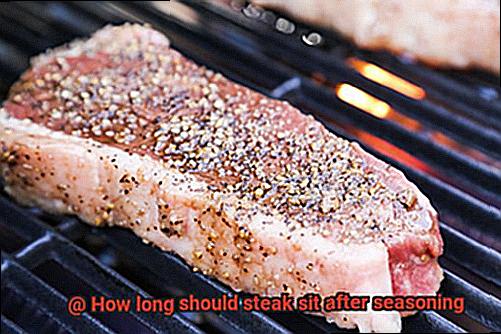
It’s essential to remember that letting your steak rest after seasoning not only allows the flavors to develop but also helps the meat retain its juices during cooking. So next time you’re seasoning up that delicious piece of meat, take these factors into account and let it rest for the optimal amount of time.
The Role of Salt in Enhancing the Flavor and Tenderizing the Meat
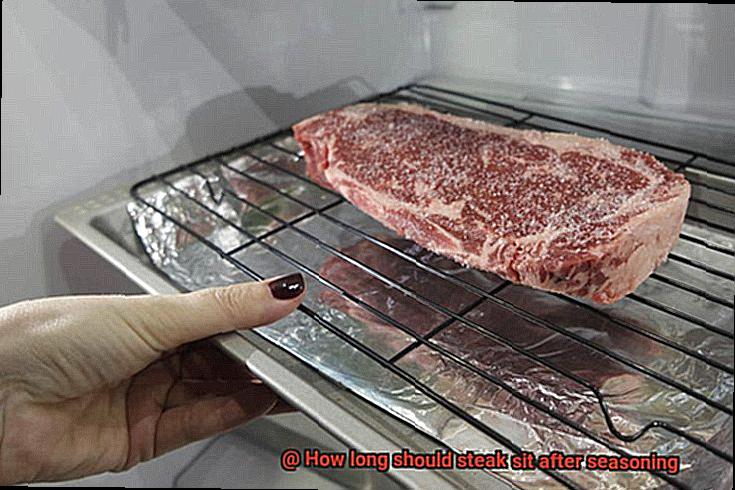
When it comes to cooking steak, seasoning it with salt is more than just a simple step. In fact, it’s a crucial ingredient that can transform a dull piece of meat into a succulent and flavorful masterpiece. Salt works its magic in two ways: by tenderizing the meat and enhancing its flavor.
Firstly, salt helps to tenderize the meat by breaking down proteins. This process is called denaturing, and it allows the meat fibers to relax and become more tender. So, if you’ve ever wondered why your steak was tough and chewy, you might have missed out on adding enough salt.
In addition to that, salt also draws out moisture from the meat. You might think this would make the steak drier, but it’s actually quite the opposite. The moisture that gets extracted mixes with the salt to form a brine which then gets reabsorbed into the meat during cooking. This results in a juicier and more succulent steak.
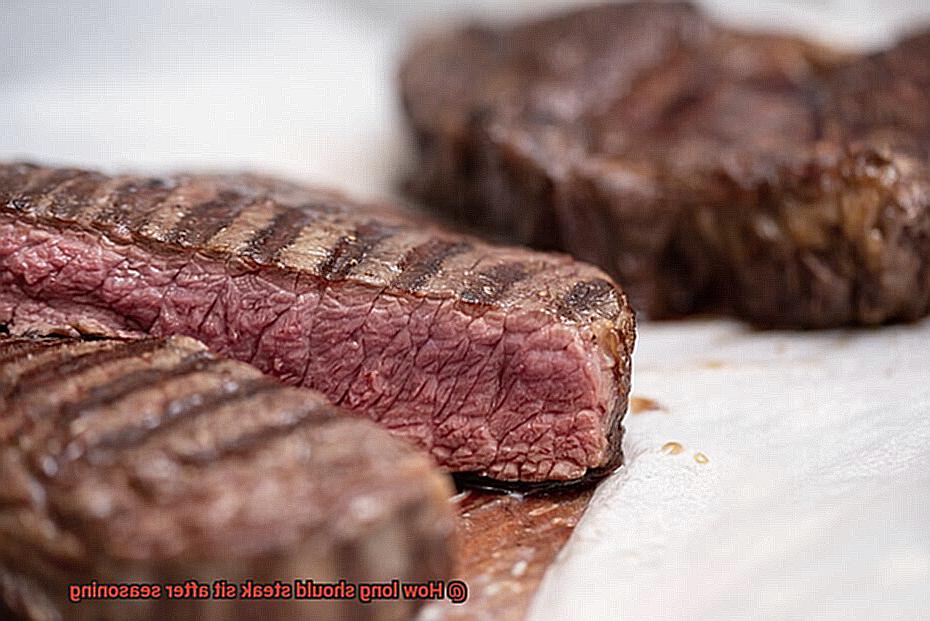
But how much salt should you use? And how long should you let it sit on the steak before cooking? The answer depends on several factors such as the thickness of the cut and type of salt used. As a general rule of thumb, letting your steak sit with salt for at least 40 minutes but no more than 2 hours is recommended. This resting time allows the seasoning to penetrate deeper into thicker cuts.
When it comes to choosing a type of salt, finer salts like table salt require less time to take effect compared to coarser salts such as kosher salt. However, be cautious not to exceed the recommended resting time as leaving the salt on for too long could result in an overly salty taste.
Adding salt to your steak is essential for achieving optimal flavor and tenderness. By following these simple guidelines, you’ll be able to elevate your steak game and impress your taste buds every time.
General Recommended Resting Time for Steaks After Seasoning
You know that seasoning is the magical ingredient that can turn a dull piece of meat into a delectable feast. But what if we told you that the secret to achieving a juicy and tender steak lies in allowing it to rest after seasoning?

The general recommended resting time for steaks after seasoning is about 10-20 minutes. During this time, your steak will reach room temperature and the seasoning will fully penetrate the meat. However, keep in mind that the exact resting time may vary depending on the thickness of your steak. Thicker cuts will require more time to rest while thinner cuts will need less.
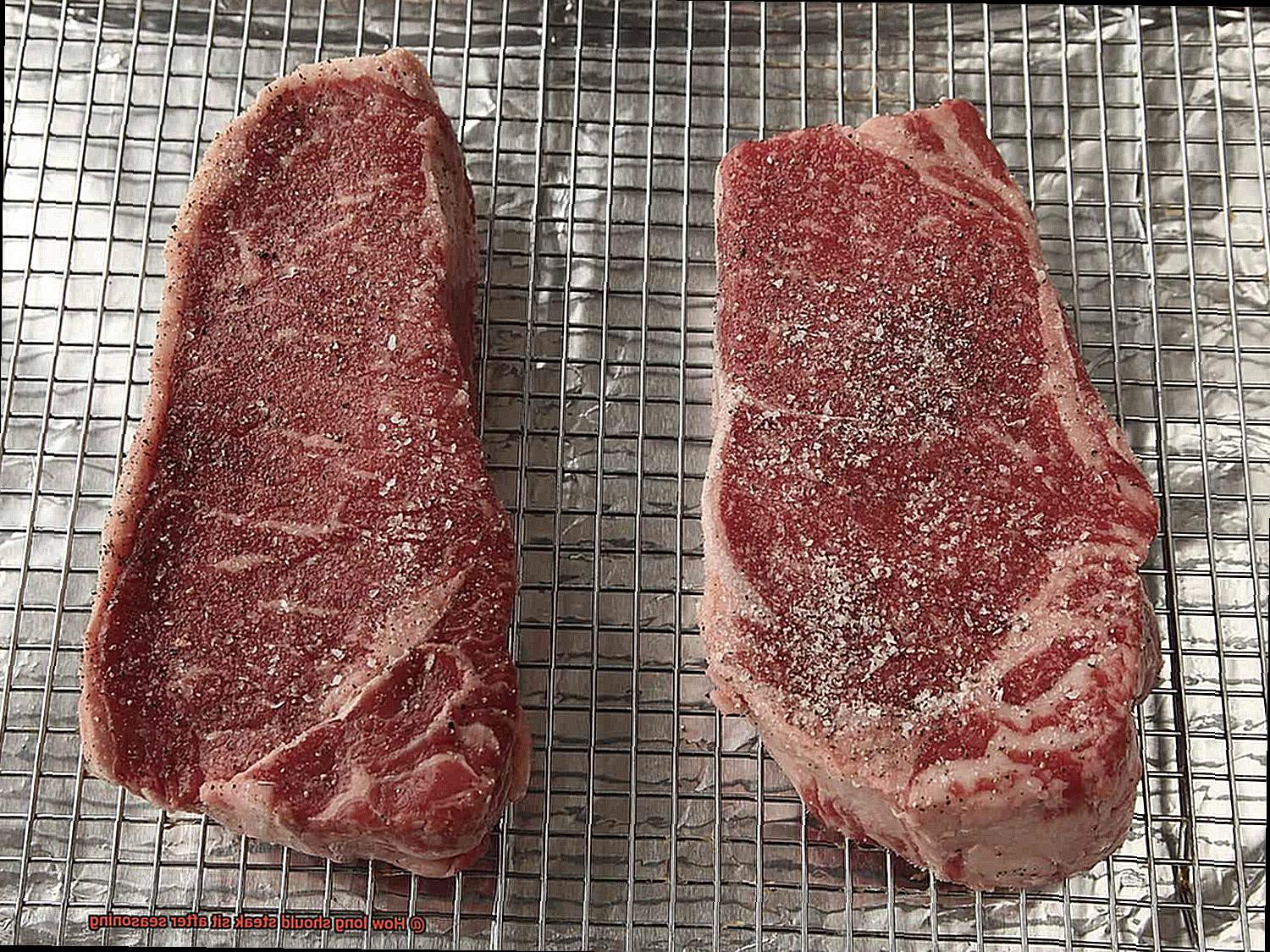
Now here’s the trick: during the resting time, cover your steak with foil or a lid to keep it warm. This will help retain the moisture in the meat, and ultimately result in a juicier steak. Trust us, cutting into your steak too soon will cause all those delicious juices to escape, leaving you with a dry and tough piece of meat.
But what about the type of seasoning used? If you opted for a dry rub or marinade, you may need to let your steak rest for longer to allow those flavors to fully develop. On the other hand, if you simply seasoned your steak with salt and pepper, a shorter resting time may suffice.
Remember, achieving the perfect steak requires patience and attention to detail. Take note of the thickness of your steak and the type of seasoning used when determining its exact resting time.

Adjusting Resting Time Based on Thickness of the Steak
Here, we’ll explore why adjusting resting time based on the thickness of your steak is crucial for achieving the perfect, succulent steak.
Think of your steak as a luxurious mansion, with each inch of thickness representing a new level. The thicker the walls, the longer it takes for heat to penetrate through them – just like a thicker steak requires more time to rest. The golden rule here is five minutes of rest per inch of thickness.
If you have a two-inch thick steak, you should let it rest for at least ten minutes after seasoning before cooking. This will give it ample time for the heat to distribute evenly throughout the meat and for those mouth-watering juices to redistribute evenly throughout the steak. Cutting into it too soon would be like tearing down a mansion’s walls before they’re even finished – you’d lose all that decadent flavor.
On the other hand, a thinner steak that’s around half an inch thick may only need two to three minutes of resting time before cooking. Since there’s less meat for the heat to travel through, it won’t take as long for it to reach the center of the steak.
It’s vital to remember that these are just guidelines, and individual preferences may vary. If you prefer your steaks rare, you might not need as much resting time. However, if you prefer them well-done, you may require additional resting time.
Adjusting resting time based on thickness is a crucial step in achieving a perfectly cooked steak. By allowing enough time for your steak to rest after seasoning, you’ll be able to savor every juicy and flavorful bite.
Personal Preference and Experimentation with Different Rest Times
Think of your steak as a canvas waiting to be painted. Just like an artist experiments with different colors and techniques, you can experiment with different rest times to find what works best for your taste buds.
Firstly, consider the cut and thickness of your steak. Thicker cuts require more rest time than thinner ones. A general rule of thumb is to aim for five minutes of rest per inch of thickness, but don’t hesitate to adjust based on your personal preference.
Speaking of personal preference, this is where experimentation comes into play. Some may prefer their steak served immediately after cooking, while others like to let it sit for a few minutes. The amount of rest time also affects the level of doneness – those who prefer their steak more well-done may not want to let it sit for as long as those who like it rare or medium-rare.
So, how can you experiment with rest times? Cook multiple steaks at once and let each one rest for a different amount of time. This way, you can taste-test and see which rest time yields the best results for your taste buds.
Remember that resting your steak allows the juices to redistribute throughout the meat, resulting in a more tender and flavorful final product. But don’t be afraid to play around with rest times to find what works best for you.
Benefits of Allowing Steak to Sit After Seasoning
You’ve got your favorite seasoning blend ready to go, and you’re eager to start cooking your steak. But before you fire up the grill, take a moment to consider the benefits of letting your steak sit after seasoning.
First and foremost, giving your steak some time to rest after seasoning allows the flavors to fully infuse into the meat. If you cook your steak right away, the seasoning will only sit on the surface, failing to penetrate the meat’s core. But by waiting a few minutes or even hours, the salt and other seasonings have time to seep into the meat, resulting in a more flavorful and evenly seasoned steak.
But that’s not all – letting your steak sit after seasoning also helps it reach room temperature. Cooking a cold piece of meat straight from the fridge can lead to uneven cooking and an unpleasant texture. By allowing your steak to sit at room temperature for 30 minutes to an hour after seasoning, it will cook more evenly and result in a more tender and juicy finished product.
In addition, giving your steak some time after seasoning can aid in caramelization. That beautiful golden-brown crust on the outside of a perfectly cooked steak is achieved through caramelization. Allowing your meat to sit after seasoning draws out some of its moisture from the surface, which leads to better browning and caramelization during cooking.
Allowing your steak to sit after seasoning is a simple yet effective technique for enhancing its flavor, texture, and appearance. So next time you’re ready to grill up some steaks, take a step back and let those flavors marinate before throwing them on the heat.
Tips for Preparing the Perfect Steak Every Time
If you’re a steak connoisseur, then you know that the key to achieving the perfect cut is in the seasoning, room temperature, and cooking method. From the right amount of seasoning to the appropriate resting time, here are five tips to help you prepare the perfect steak every time:
Season generously
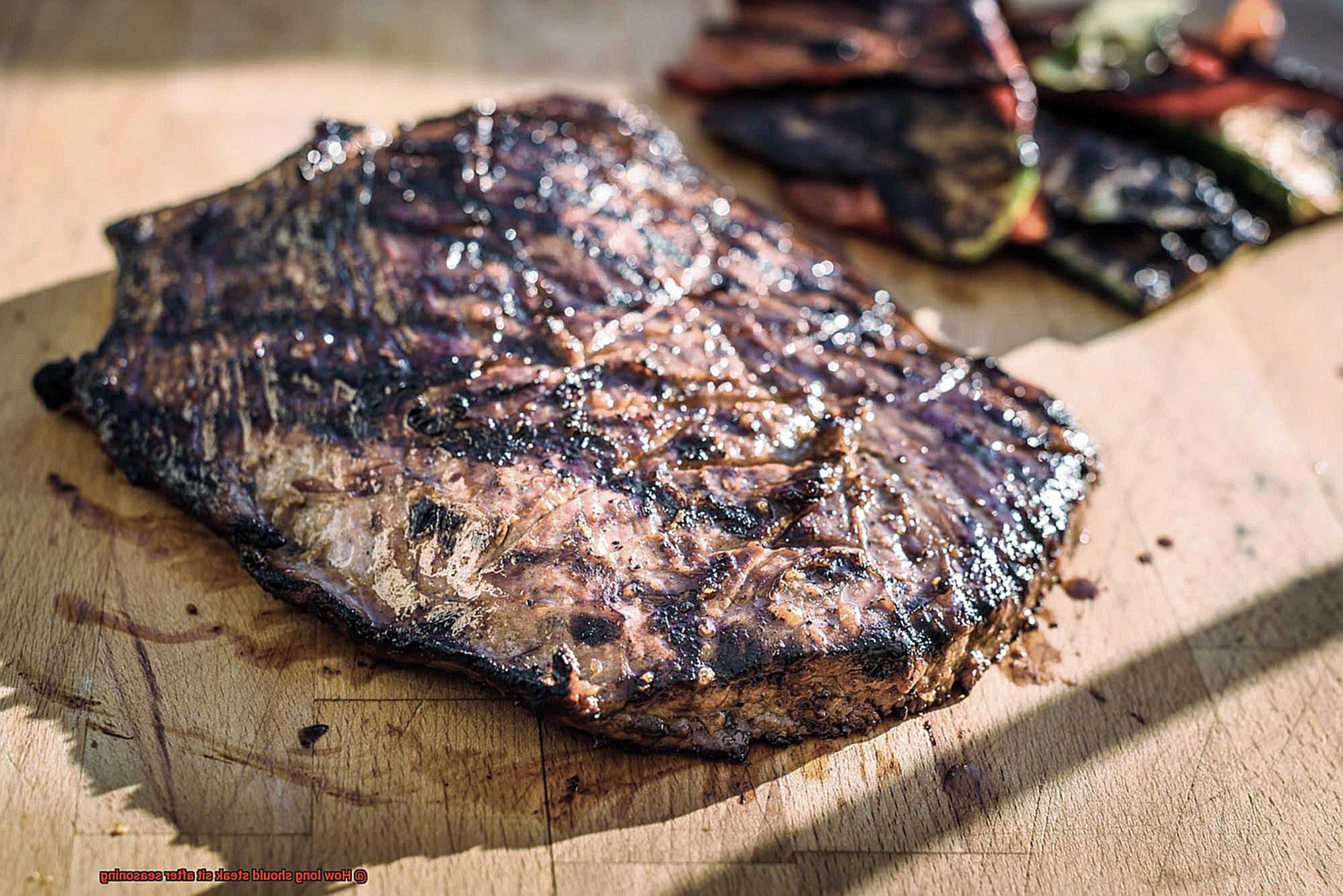
When it comes to seasoning, don’t hold back. Generously coat your steak with salt and pepper, or experiment with herbs, spices, and marinades. However, be mindful of how long you let your steak sit after seasoning. Too much time can overpower the flavor.
Let it come to room temperature
Once seasoned, let your steak rest at room temperature for about 30 minutes before cooking. This allows the seasoning to penetrate the meat and helps ensure even cooking.
Don’t let it sit for too long
While letting your steak rest after seasoning is crucial, don’t leave it out for too long. Waiting for more than an hour can cause your steak to lose its flavor and dry out.
Adjust based on seasoning type
The length of time you let your steak rest after seasoning can also depend on the type of seasoning used. For example, if you marinated your steak, it may need a few hours in the fridge to fully absorb the flavors.
Cook to your liking
Finally, remember that cooking methods and temperatures play a crucial role in achieving that perfect steak. Whether you prefer rare or well-done, make sure to adjust cooking times and temperatures accordingly.
Preparing the perfect steak requires attention to detail and patience. By following these tips and experimenting with different resting times and seasonings, you’ll be able to create a delicious and tender cut of meat every time.
2ua_v4BA3qM” >
Conclusion
To achieve a mouthwatering steak, it’s important to give your seasoning enough time to work its magic. We recommend resting your steak for at least 30 minutes after seasoning, but if you have more time on your hands, letting it marinate overnight in the fridge can result in an even more tender and flavorful steak. It’s important to adjust resting times based on factors such as the type of seasoning used and the thickness of the steak.
Personalizing your perfect steak is all about experimentation with different rest times and seasonings. Season generously, let it come to room temperature before cooking, and adjust cooking methods and temperatures according to your preferences.
Remember that allowing your steak to sit after seasoning not only allows the flavors to develop but also helps the meat retain its juices during cooking.






